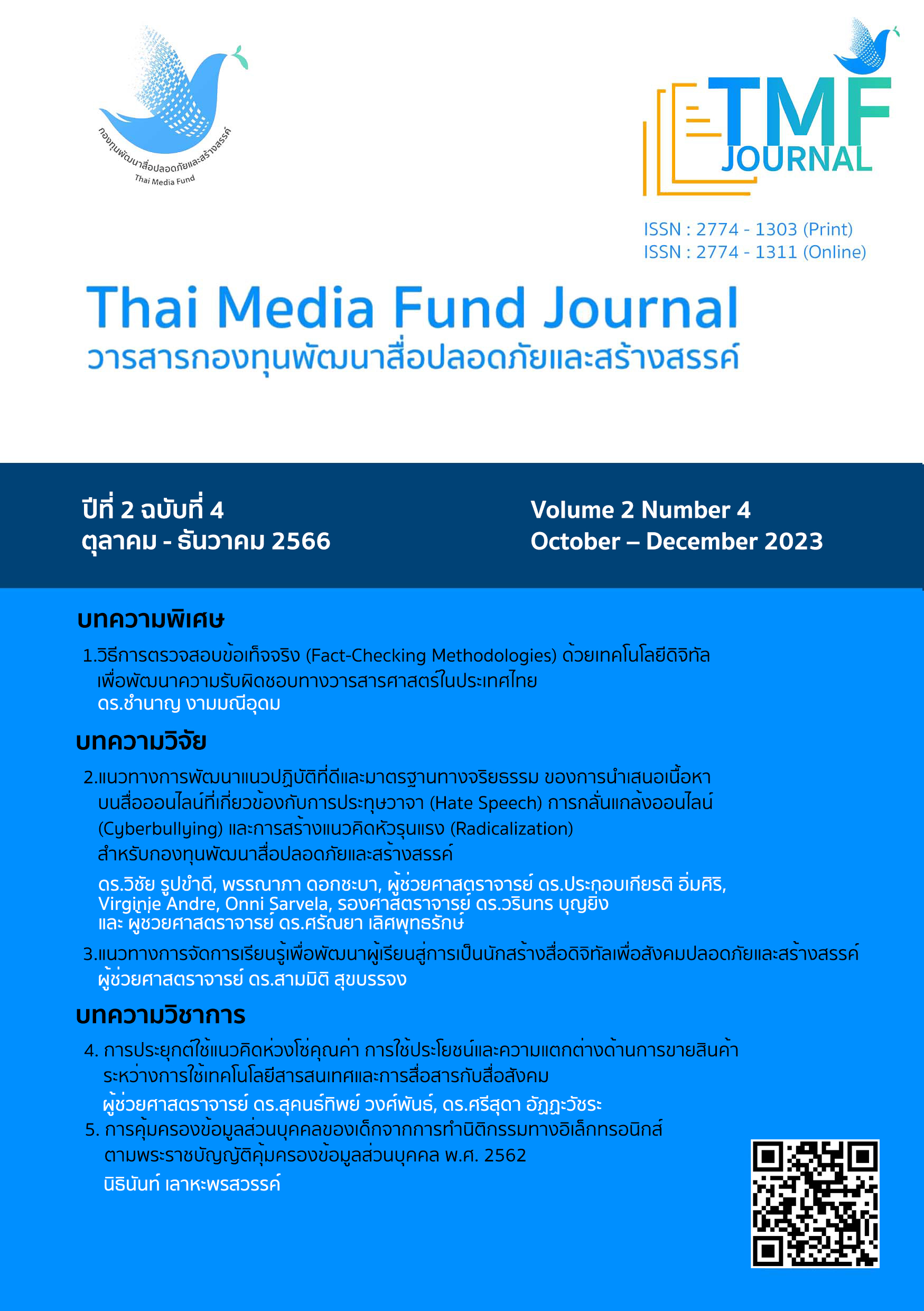วิธีการตรวจสอบข้อเท็จจริง (Fact-Checking Methodologies) ด้วยเทคโนโลยีดิจิทัลเพื่อพัฒนาความรับผิดชอบทางวารสารศาสตร์ในประเทศไทย
Main Article Content
บทคัดย่อ
สังคมยุคดิจิทัลในปัจจุบัน ข้อมูลข่าวสารจำนวนมหาศาลถูกผลิต และเผยแพร่ผ่านเครือข่ายอินเทอร์เน็ตอย่างรวดเร็ว สร้างให้เกิดการเปลี่ยนแปลงของระบบนิเวศน์ทางวารสารศาสตร์จากเดิมที่สำนักข่าวมีความสำคัญในการบรรณาธิการ และตรวจสอบความถูกต้องของข่าวสาร เริ่มถูกท้าทายด้วยความรวดเร็ว และการแข่งขันที่เพิ่มมากยิ่งขึ้น ประกอบกับพัฒนาการของสื่อใหม่ผ่านทางออนไลน์ส่งผลให้พฤติกรรมในการรับข่าวของพลเมืองทั่วโลกเปลี่ยนแปลงไป ในประเทศสหรัฐอเมริกา พบว่า ยอดการอ่านข่าวผ่านทางแพลตฟอร์มออนไลน์ มีจำนวนกว่า 32 ล้านการเข้าชม (Unique Visits) ต่อเดือนในช่วงปี ค.ศ. 2020 (Pew Research Center, 2021) สำหรับในประเทศไทย ร้อยละ 92 ของพลเมืองไทยอ่านข่าวออนไลน์อย่างน้อย 1 ข่าวต่อวัน ซึ่งเป็นสัดส่วนที่สูงที่สุดในทวีปเอเชีย และอ่านข่าวอย่างหลากหลาย โดยมีประเภทข่าวเฉลี่ย 7.4 ประเภท ซึ่งเป็นค่าเฉลี่ยที่สูงที่สุดในเอเชียเช่นกัน แสดงถึงความสนใจในประเภทข่าวออนไลน์ที่หลากหลายที่สุด โดยให้ความสนใจกับข่าวในประเทศ มากเป็นอันดับที่หนึ่ง รองลงมาเป็นอันดับสอง คือ ข่าวเศรษฐกิจ ตามมาด้วยอันดับสาม คือ ข่าวการเมือง อันดับสี่ คือ ข่าวบันเทิง และ อันดับห้า คือ ข่าวเทคโนโลยี
Article Details

อนุญาตภายใต้เงื่อนไข Creative Commons Attribution-NonCommercial-NoDerivatives 4.0 International License.
เอกสารอ้างอิง
บรรณานุกรม
Arun, C. (2019). On WhatsApp, Rumours, and Lynchings. Economic & Political Weekly, 30–35.
Bangkok Post & Thai Media Fund. (2021, June 15). Covid-19 and “fake news” in Thailand. Retrieved from Bangkok Post & Thai Media Fund: https://www.bangkokpost.com/specials/data-visualization/
Boonwara Sumano, & Archawin Asavapisitkul. (2020, November 9). Public Broadcasters' Responsibilities and Challenges in New Digital Age when Everyone can be Media. Retrieved from Thailand Development Research Institute: https://tdri.or.th/2020/11/the-role-of-public-broadcaster/
California State University. (2023, August 21). How To Read Laterally. Retrieved October 8, 2023, from California State University: https://libguides.csun.edu/journalism/reading-laterally-fact-checking
Cooper, S. (2007). A concise history of the fauxtography blogstorm in the 2006 Lebanon war. American Communication Journal, 9.
de Carvalho, J. T., Faria, A. F., He´lio´, P., Torres, d. R., & Rocha, A. (2016). Illuminant-based transformed spaces for image forensics. IEEE Transactions on Information Forensics and Security, 11, 720–733.
Higgins, E. (2014, July 9). A Beginner's Guide to Geolocating Videos. Retrieved October 22, 2023, from Bellingcat: https://www.bellingcat.com/resources/how-tos/2014/07/09/a-beginners-guide-to-geolocation/
Karczmarczyka, A., Jankowskia, J., & Sałabun, W. (2017). Linguistic Query Based Quality Evaluation of Selected Image Search Engines. Procedia Computer Science, 112, 1809–1818.
Marketeer. (2020, May 18). Online News Consumption Behaviors among Thai Consumers. Retrieved from Marketeer: https://marketeeronline.co/archives/165179
McDonnell, J. P., & Sanchez, C. (2018, September 21). When fake news kills: Lynchings in Mexico are linked to viral child-kidnap rumors. Retrieved from Los Angeles Times: https://www.latimes.com/world/la-fg-mexico-vigilantes-20180921-story.html
Moynihan, D., & Weisman, S. (2010). Daniel Patrick Moynihan. New York: PublicAffairs.
Pew Research Center. (2021, July 27). Digital News Fact Sheet. Retrieved from Pew Research Center: https://www.pewresearch.org/journalism/fact-sheet/digital-news/
Prabhakar, T., Nadig, K., Gupta, A., & George, D. (2020, September 15). Check Mate: Prioritizing User Generated Multi-Media Content for Fact-Checking. Retrieved October 6, 2023, from Cornell University: https://arxiv.org/abs/2010.13387
Sittmann, J. (2020, August 10). Fact-checking: A curated guide to resources and ideas. Retrieved October 9, 2023, from DW Akademie: https://akademie.dw.com/en/fact-checking-a-curated-guide-to-resources-and-ideas/a-54509776
Tešić, J. (2005). Metadata Practices for Consumer Photos. IEEE Multimedia, 12(3), 86-92.
The News Literacy Project. (2023). Expand your view with lateral reading. Retrieved October 6, 2023, from The News Literacy Project: https://newslit.org/tips-tools/expand-your-view-with-lateral-reading/
UNESCO. (2018). Journalism, ‘Fake News’ & Disinformation. Paris: UNESCO.
Wardle, C. (2017, February 17). First Draft. Retrieved August 17, 2023, from Fake news. It's complicated.: https://medium.com/1st-draft/fake-news-its-complicated-d0f773766c79#id_token=eyJhbGciOiJSUzI1NiIsImtpZCI6IjdjOWM3OGUzYjAwZTFiYjA5MmQyNDZjODg3YjExMjIwYzg3YjdkMjAiLCJ0eXAiOiJKV1QifQ.eyJpc3MiOiJodHRwczovL2FjY291bnRzLmdvb2dsZS5jb20iLCJhenAiOiIyMTYyOTYwMzU4MzQ
Yang, S., Shu, K., Wang, S., Gu, R., Wu, F., & Liu, H. (33). Unsupervised Fake News Detection on Social Media: A Generative Approach. Proceedings of the AAAI Conference on Artificial Intelligence, 5644–5651.
Zlatkova, D., Nakov, P., & Koychev, I. (2019). Fact-Checking Meets Fauxtography: Verifying Claims About Images. The 2019 Conference on Empirical Methods in Natural Language Processing and the 9th International Joint Conference on Natural Language Processing (pp. 2099–2108). Hong Kong, China: Association for Computational Linguistics.


